Clint Eastwood’s biopic J. Edgar follows the story of the first FBI chief, J. Edgar Hoover, throughout his controversial 50 year career. To help portray some of the key events in Hoover’s time, such as presidential inaugurations of the 1930s and 60s in Washington D.C., the Broadway scene and the Chicago race riots, Eastwood turned to long-time visual effects collaborators Michael Owens and Method Studios in Vancouver. We talk to Method about their crowd and virtual environment solutions for the film and approach to the invisible effects work.
– Watch the trailer for ‘J. Edgar’, featuring a number of visual effects shots by Method Studios in Vancouver.
Click here to listen to a fxpodcast with overall visual effects supervisor Michael Owens, who discusses the J. Edgar’s make-up work and the VFX storytelling approach to his contributions to Clint Eastwood’s films.
How to make a motorcade
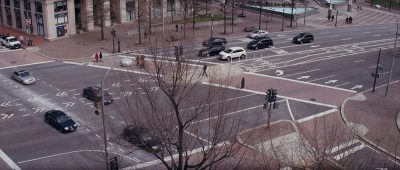
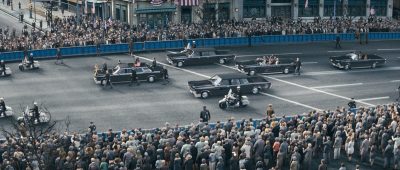
Two inaugural motorcades for presidents Franklin D. Roosevelt, in 1933, and Richard Nixon in 1969 are featured in the film. Method recreated different versions of Pennsylvania Avenue for each time period, adding cars, buildings and crowds. Looking from Hoover’s office balcony, the scenes feature people waving, Secret Service agents, police, military and marching bands – all as digital mo-cap’d performances. “We did a number of mo-cap sessions for the parade so that we had actors in concert marching in step with each other, doing the various military and marching band things,” explains Method visual effects supervisor Geoffrey Hancock. “We captured four to six actors at a time and then we would playback the previous capture, and then capture again as if they were the next row. Then after that we cut them all up separately so we could create blocks as big as wanted and as long as we wanted, to vary the marching step to make it look natural.”
Although the Secret Service, police and military personnel were all captured specifically for J. Edgar, most of the pedestrians and spectators could be pulled from Method’s existing library, including captures from Eastwood’s earlier rugby feature Invictus, for which Method filled out vast stadiums with cheering digital fans. As on that film, Massive was used primarily as a motion editor, with some brains and agents created to take advantage of individual motion capture clips for longer walk cycles and cheering. However, Method has been continually refining its crowd solution so that it can both take advantage of Houdini’s point-based system, allowing for quick iterations and changes, right up into the lighting and compositing stages.
“We wanted something that was flexible, something that let us art direct any parts of a crowd at any time,” says Ollie Rankin, also one of Method’s visual effects supervisor on the show. “We’ve developed a crowd system where we try to cache out into the most efficient formats that we could, all of the behavioral characteristics of the motion captured performances of the crowd to separate the clothing they were wearing, and as much as possible, the skeletons, from any decisions about the animation or behavior. And the textures are divorced from the clothing so that they can be changed even in the comp.”
According to Rankin, Method chose Houdini as it could be used to efficiently manipulate point clouds standing in for the crowds. “You can think of a crowd as being a significant point cloud,” notes Rankin. “Every agent in the crowd is represented by a point and among the attributes on that point could be their character body type, their behavior choice – whether they’re standing around doing nothing or smoking a cigarette or reading a newspaper. Another attribute could be their choice of clothing or whether they’re slim or fat.”
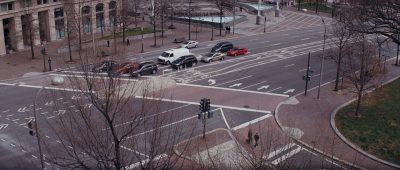
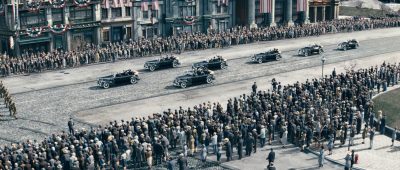
Method adapted its crowd system to export from Massive a representation of the characters into the Houdini point cloud format. Then, artists wrote a set of tools inside Houdini for manipulating the attributes on those point clouds, re-positioning them or altering on an individual level or across the global crowd, or even in certain small sections of the crowd to be able to manipulate attributes. Says Rankin: “We would be able to paint in ‘oldness’, so we could say, ‘Where this brush lands put old people or where this lasso area is let’s have half of the people wear blue clothing and in this corner let’s make everybody more energetic and have to wear a team jersey’ – that sort of thing.”
By separating the behavior from the appearance of the characters, artists could continue to make tweaks to the crowds throughout the process. “What it meant was that you could even have two different people if necessary working on the layout of the shot,” comments Rankin. “One person could be art-directing the behavior of the characters while another would be directing the distribution of clothing. That was quite useful. That meant a client was able to make a change to a shot that had got all the way into compositing say to remove or replace one particular character.”
To fill out the Pennsylvania Street scenes and other views beyond windows over the two eras, Method looked to both reference photographs and LIDAR scans taken of the area by a survey crew. “We also had an art director on the team who had some experience with architecture previously in his career,” says Rankin. “He was able to research the style of buildings we might find at that time and place. We built a small library of buildings that could be used to populate those areas.”
For shots during the parades, and for views out of vehicle interiors, artists replicated era-appropriate flags and buntings and took care to add shadows and reflections in the CG car windows and buildings. “The trees were another interesting aspect of those shots,” recalled Rankin, “because the trees that line Pennsylvania Avenue today have been there throughout those periods of history. We had to reverse-age the trees that were there to fit the two eras that we were digitally re-creating.”
On Broadway
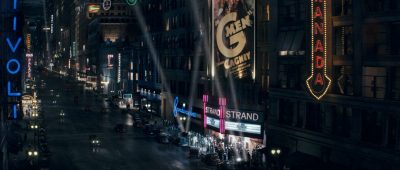 In one sequence, Hoover visits the Broadway theater and entertainment district in New York. Production shot in Los Angeles, and then extended the scene with marquee signs, crawling lights and theater fronts. “Neon had just come into popular use in the 30s so we had all these classical signs to replicate,” says Hancock. “There’s one high aerial shot where we come in into the premiere of a movie that Hoover’s attending. Another one is as they’re exiting – they shot a plate in LA leaving the theater and we kept only the theater front and the car they’re moving away in. Then we had to put in all the traffic and the people and an expanded street – about three or four times bigger than what they had shot on.”
In one sequence, Hoover visits the Broadway theater and entertainment district in New York. Production shot in Los Angeles, and then extended the scene with marquee signs, crawling lights and theater fronts. “Neon had just come into popular use in the 30s so we had all these classical signs to replicate,” says Hancock. “There’s one high aerial shot where we come in into the premiere of a movie that Hoover’s attending. Another one is as they’re exiting – they shot a plate in LA leaving the theater and we kept only the theater front and the car they’re moving away in. Then we had to put in all the traffic and the people and an expanded street – about three or four times bigger than what they had shot on.”
As reference, Eastwood provided Method with a specific set of black and white photographs that, says Rankin, “were moody, contrasty and grainy and portrayed a certain feel of the time.” On set, production had also hosed the street down to amplify reflections for the lights. But by the time they shot the takes, the road had mostly dried, so artists augmented the patchy wet and dry live action road and matched it to a CG road, cars and people. In addition, the environment lighting came from HDRs taken by Method at a nightclub district in Vancouver.
Burning Chicago
The Chicago race riots of 1968 are also featured in the film, albeit briefly. “That was a line we saw in the script and we thought, well, ‘Will the production go to Chicago? Will they find a similar skyline?’,” notes Hancock. “We did some concepts and previs and craning camera moves throughout the street looking at different ways that we could show the riots both at street level and rooftop level. In the end, it became a virtual matte painting shot.”
The fire itself came from practical elements, including a few ‘fiery’ blasts. Method also added in a set of blackouts cascading into the distance as the riots knocked out the city’s power. “Essentially we had to come up with one shot,” says Rankin, “that conveyed, in just a few seconds, all of the chaos that was going on at the time. So we looked at various reference, and then we started piecing together the city of Chicago from photos. It was one very large matte painting that came to life with smoke and fire and reflections and shadows.”
Matching colors and style
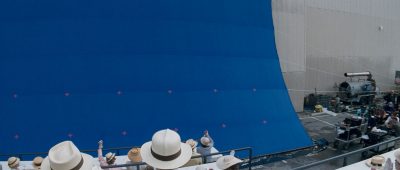
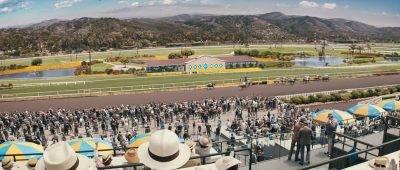
J. Edgar’s desaturated and contrasty look, a trademark of the director’s work, was a key challenge for the visual effects crew. “Clint’s films have a distinctive DI treatment which is very contrasty and has muted colors,” observes Hancock. “The crew tend to use a really old set of lenses and they often have pretty grainy film stock. We were always conscious to pay special attention to the film stock they were using and how we were going to emulate that with our digital renders and how we were going to compare that with our digital reference stills we were taking on location.”
“Traditionally,” adds Hancock, “a lot of matching happens by eye by various compositors. What we’ve been finding on projects is that there’s a lot more subtle characteristics in a film stock than just immediately meets the eye. We ended up taking a more qualitative look at that translation from digital to linear, and linear to specific film stock, which really helped tie in with the existing material.”
Eastwood’s style of filmmaking, too, was something Method strove to match, in conjunction with the effects philosophy of supervisor Michael Owens. “Michael says he always approaches every VFX challenge with a cinematic storytelling eye,” relates Ollie Rankin. “His first duty is to the cinema, to the story. He’s not afraid to re-edit a sequence or propose changes to the way a scene unfolds to better tell a story in order to make the best use of the VFX that are available.”
“There’s a real satisfaction working on the invisible effects in Clint’s films,” concurs Hancock. “His growing awareness of visual effects has let him use it in two ways; one is as a quick way to know where he can take shortcuts on set and the other is as a way to expand upon the story with new or virtual shots – maybe locations that they weren’t going to be able to get to, or to describe the vast area within a time period that would be prohibitive to create practically. So he really uses visual effects to increase the scope of his films, in relation to telling the story, as opposed to eye candy.”
All images © 2011 Warner Bros. Entertainment Inc. All rights reserved. Images courtesy Method Studios Vancouver.
